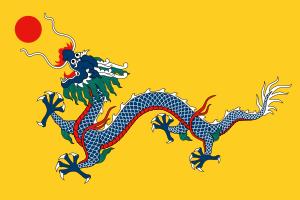Ma Biao (1885–1948) (simplified Chinese: 马彪; traditional Chinese: 馬彪; pinyin: Mǎ Biāo; Wade–Giles: Ma Piao) was a Chinese Muslim Ma Clique General in the National Revolutionary Army, and served under Ma Bufang, the Governor of Qinghai. He was a member of Ma Bufang's family, Ma Biao was the eldest son of Ma Haiqing 馬海清, who was the sixth younger brother of Ma Haiyan, the grandfather of Ma Bufang. Ma was too young to participate in the First Sino-Japanese War, in which he wanted to fight. He then joined the Kansu Braves, serving under Ma Haiyan, fought against the foreigners in the Boxer Rebellion at the Battle of Peking (1900) and helped guard the Imperial Court when it evacuated to Xi'an. He was prominent in the Qinghai – Tibet War, a theater of the Sino-Tibetan War. He was sent by Ma Bufang to create an incident against the Tibetan army at a monastery at Yushu. This set off the Qinghai Tibet War. He was commander of Yushu Defense Command, Qinghai Province, and he also led the 1st Provisional Cavalry Division, 8th Cavalry Division, 2nd Cavalry Army, and served on the Military Advisory Council. Ma Biao participated in encirclement campaigns against the Communists. He fought in the Second Sino-Japanese War and in the Chinese Civil War. His rank was Lieutenant-General. Immediately after the Marco Polo Bridge Incident, Ma Bufang arranged for a cavalry division under Muslim General Ma Lu 馬祿 and another cavalry division under Ma Biao to be sent east to battle the Japanese. Ethnic Turkic Salar Muslims made up the majority of the first cavalry division which was sent by Ma Bufang. “恨不得馬踏倭鬼,給我已死先烈雪仇,與後輩爭光”。 "I am eager to stomp on the dwarf devils (A derogatory term for Japanese), I will give vengeance for the already dead martyrs, achieving glory with the younger generation." said by Ma Biao with reference to his service in the Boxer Rebellion where he already fought the Japanese before World War II. By the time of World War II he had been in the military for over 40 years, and his service in World War II against the Japanese was regarded as the pinnacle of his achievements by himself. Ma Biao crushed the Japanese at the Battle of Huaiyang. Ma Bufang's army battled extensively in bloody battles against the Japanese in Henan province and fought against White Lotus elements who had allied with the Japanese. The Qinghai Chinese, Salar, Chinese Muslim, Dongxiang, and Tibetan troops were under the commander of Ma Biao, being sent to fight to the death against the Imperial Japanese Army, or committed suicide refusing to be taken prisoner, instead, they committed suicide when cornered by the enemy. When they defeated the Japanese, the Muslim troops slaughtered all of them except for a few prisoners to send back to Qinghai prove that they were victorious. In September 1940, when the Japanese made an offensive against the Muslim Qinghai troops, the Muslims ambushed them and killed so many of them they were forced to retreat. The Japanese could not even pick up their dead, they instead cut an arm from their corpses limbs for cremation to send back to Japan. The Japanese did not dare make an offensive like that again. They were known as 马胡子军 or 马回子军 by the Japanese. During World War II, the China Information Publishing Company included an article on Ma Biao in Volume 4 of its publication "China at War", which discussed both his service in the Boxer Rebellion in 1900 and his fight against the Japanese in World War II in Henan. According to the article, he knew four languages: an indigenous dialect, Tibetan, Arabic, and Chinese. Tibetan Lamaists (Tibetan Buddhists) made up 20% of his soldiers, Han Chinese made up 30% of his soldiers, and various Muslim ethnicities made up the remaining 50%. He had a beard. Ma Biao was forced to retire and leave the battlefield at great relectuance. Ma Biao's relative Ma Bukang succeeded him as 8th Cavalry Division commander in the summer of 1942 and proceeded to battle the Japanese. Ma Biao died at age 63 due to a car accident in Xining.

Lealtad
20px|Flag of the Republic of ChinaRepublic of China
20px|Flag of the Qing dynastyQing dynasty
Batalla
http://didactalia.net/items/MilitaryConflict_8869de7e-ddfa-4cdb-ba47-6bcbc58fd7cf_d318b4ad-d1c0-480d-a5bc-26c85387fc31
http://didactalia.net/items/MilitaryConflict_be5892a8-9893-481b-9687-0d8002ec13e4_a35cc1fe-6dc4-43e3-8087-a0bfa57ed224
http://didactalia.net/items/MilitaryConflict_4709b701-4dcc-4b80-a89c-248ce5eff8d9_bd2963a3-3d7f-460d-99d2-739491c3f6ea
Fecha de nacimiento
1885-01-01
Fecha de defunción
1948-01-01
Comando militar
Yushu Defense
Fin de servicio (año)
1948
Inicio de servicio (año)
1900



Commenter
0